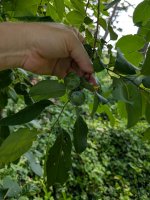Bonsai Nut
Nuttier than your average Nut
Refreshing a great thread...
Took me a while to locate them, but I've got two females in my landscape. I keep looking for @NaoTK , because I am hoping to locate a tree for him, but I have many, many males... and only two females (that I have found). Now that I have located them, I can start to give them some love. Right now we are still working on clearing / removing the trees we don't want, and keeping the trees we do. These are native trees - ie not cultivars.

Took me a while to locate them, but I've got two females in my landscape. I keep looking for @NaoTK , because I am hoping to locate a tree for him, but I have many, many males... and only two females (that I have found). Now that I have located them, I can start to give them some love. Right now we are still working on clearing / removing the trees we don't want, and keeping the trees we do. These are native trees - ie not cultivars.

